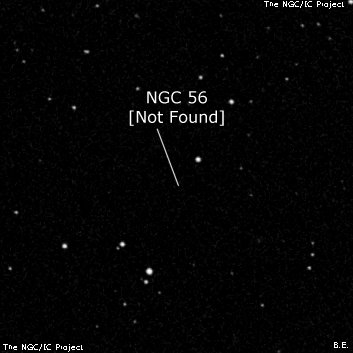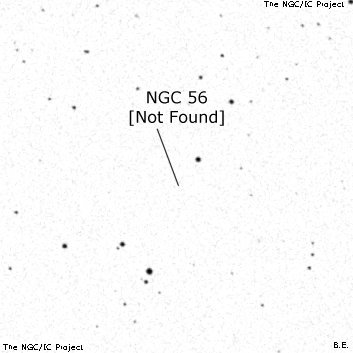NGC/IC Project Restoration Effort
(This is a very very beta version)
NGC56


Basic Information
Location and Magnitude
Right Ascension: 0:15:20.6
Declination: +12:26:40
Constellation: PSC
Visual Magnitude:
Historic Information
Discoverer: Herschel J.
Year of discovery: 1825
Discovery aperture: 18.3
Observational
Summary description: eF, eL, diff
Sub-type: NF
Corwin's Notes
=====
NGC 56 is lost. It may have been the edge of the gegenschein, or another part
of the zodiacal dust, but I think that is unlikely. Dave Riddle has also
suggested that it could be part of the infrared "cirrus" in the area (the IRAS
100-micron image shows it well), mirrored by a recent (2006) observation of
carbon monoxide there. However, I don't think that this will work, either.
Whatever happened, there is certainly more to the story than I typed in a few
years ago. Here is what I previously wrote:
NGC 56 does not exist. John Herschel recorded it only once very early in
his observing career (Sweep 14 in 1825), saying, "About this place a
considerable space seems affected with nebulosity." There is a possibility
that he saw a reflection of the bright star 2 degrees north, but there is no
other reasonable explanation for the observation. The other objects that he
recorded in Sweep 14 (including M 15) are all in the same area of the sky,
so there is no gross error in the position.
JH's observation took place on 13 October 1825. Assuming that what he saw was
indeed the gegenschein, and that its peak brightness is exactly opposite the
sun, it would have an ecliptic longitude of 19d 58min on that date,
corresponding to RA 01 13.7 and Dec +07 49 (B1950.0). The nominal position of
NGC 56 puts that 15d 38min away. Since the gegenschein is typically seen to
be about 10d across, it probably was not affecting Herschel's field that
night. If it was, it is also reasonable to ask why JH did not put the center
of his nebulosity nearer the gegenschein's peak.
Similar objections can be made to the IR cirrus hypothesis. The nearest
bright knot in the cirrus is about 5 degrees south and a bit east of NGC 56's
nominal position, but there is nothing at all to be seen on the visual
wavelength sky surveys anywhere in the area. Since JH was observing visually,
we want to find a visual source corresponding to his observation. It's not
there, unfortunately, so we are pretty well stuck for an explanation.
Dave also points out that there are three of WH's "extensive diffused
Nebulosity's" in the area. Is NGC 56 perhaps one of them? JH called it a
"nova" and did not mention, with respect to it, any of his father's large,
faint nebulae in notes to either his 1833 catalogue, nor in the GC of 31 years
later. The nearest of WH's nebulae to NGC 56 is 2.5 degrees away (WH's number
2 in his 1811 list published in Phil. Trans. 74, page 269). Since WH has his
estimated size at 3.3 degrees, the edge of the nebulosity is still 1.4 degrees
from the center of NGC 56. So, I would have to agree with JH that his
apparent nebulosity is not the same as that recorded by his father.
Are there more recent observations here? Dave points to several by Arthur
Searle reported in the Harvard Annals in 1900 which seems to trace the IRAS
nebulosity. But this is still well off NGC 56, so it seems unlikely to be the
same object. Similarly, IC 14 (Bigourdan 104) is sometimes suggested as a
part of JH's object. But it is clearly a faint double star; see the IC file
for that story. Bigourdan, by the way, did not find NGC 56, noting only a
13.3 mag star near the nominal place.
In the end, my conclusion is the same as it was earlier -- NGC 56 is lost.
But the story is a lot more interesting now. Thanks, Dave!
(Also see NGC 7088, "Baxendell's Unphotographable Nebula", for a similar
non-existent object.)



